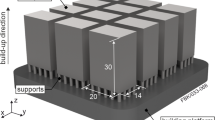Abstract
This study applied powder-tracing techniques to mount Cu and W powders on A6061-T6 aluminum sheets to investigate the material flow mechanism of friction stir spot welding (FSSW) using various geometric tools. The experimental results showed that the geometry of the tools plays a crucial role and determines the entrances of material flow during FSSW. It was believed that instantaneous voids were filled up with material flow in all directions for triangular pins, and the voids were located at the pin bottom for cylindrical pins. In accordance with the plastic rule of material flow, the pressure gradient is the necessary condition to cause material flow during FSSW; therefore, the transient constraint space (TCS) is required to generate pressure in this space. Enlargement of the TCS accompanies the evolution of the stir zone (SZ). A generated void causes a steep pressure gradient, which is regarded as the entrance of material flow. A tool with screw threads causes downward driving force, which determines the intermixing behavior between the upper and lower sheets, and also affects the size of the SZs.









Similar content being viewed by others
References
C. Schilling and J. Santos, Method and Device for Joining At Least Two Adjoining Work Pieces by Friction Welding, US Patent, No. 6722556, 2002
R. Hancock, Friction Welding of Aluminum Cuts Energy Costs by 99%, Weld J., 2004, 83, p 40
S. Kalpakjian and S.R. Schmid, Manufacturing Engineering and Technology, 6th ed., Prentice Hall, Singapore, 2010
R.S. Mishra and M.W. Mahoney, Friction Stir Welding and Processing, ASM International, Materials Park, 2007
D. Codd, Advanced, Lightweight Materials Development and Technology for Increasing Vehicle Efficiency, http://www.kvastainless.com/pdf/KVA_lightweighting_X1.pdf, December 9, 2008
X. Cao, M. Jahazi, J. Immarigeon, and W. Wallace, A Review of Laser Welding Techniques for Magnesium Alloys, J. Mater. Process. Technol., 2006, 171, p 188–204
T. Zhu, Z.W. Chen, and W. Gao, Incipient Melting in Partially Melted Zone During Arc Welding of AZ91D Magnesium Alloy, Mater. Sci. Eng. A., 2006, 416, p 246–252
J. Adamiec, The Influence of Construction Factors on the Weldability of AZ91E Alloy, Arch. Metall. Mater., 2011, 56, p 769–778
A. Kouadri and L. Barrallier, Study of Mechanical Properties of AZ91 Magnesium Alloy Welded by Laser Process Taking into Account the Anisotropy Microhardness and Residual Stresses by X-Ray Diffraction, Metall. Mater. Trans. A., 2011, 42, p 1815–1826
P. Su, A. Gerlich, T.H. North, and G.J. Bendzsak, Intermixing in Dissimilar Friction Stir Spot Welds, Metall. Mater. Trans. A, 2007, 38, p 584–595
Q. Yang, S. Mironov, Y.S. Sato, and K. Okamoto, Material Flow During Friction Stir Spot Welding, Mater. Sci. Eng. A., 2010, 527, p 4389–4398
H. Badarinarayan, Y. Shi, X. Li, and K. Okamoto, Effect of Tool Geometry on Hook Formation and Static Strength of Friction Stir Spot Welded Aluminum 5754-O Sheets, Int. J. Mach. Tools Manuf., 2009, 49, p 814–823
W. Yuan, R.S. Mishra, S. Webb, Y.L. Chen, B. Carlson, D.R. Herling, and G.J. Grant, Effect of Tool Design and Process Parameters on Properties of Al Alloy 6016 Friction Stir Spot Welds, J. Mater. Process. Technol., 2011, 211, p 972–977
S. Horie, K. Shinozaki, M. Yamamoto, and T.H. North, Experimental Investigation of Material Flow During Friction Stir Spot Welding, Sci. Technol. Weld. Join., 2010, 15, p 666–670
M. Assidi, L. Fourment, S. Guerdoux, and T. Nelson, Friction Model for Friction Stir Welding Process Simulation: Calibrations from Welding Experiments, Int. J. Mach. Tools Manuf., 2010, 50, p 143–155
D. Kim, H. Badarinarayan, I. Ryu, J. Kim, C. Kim, K. Okamoto, R.H. Wagoner, and K. Chung, Numerical Simulation of Friction Stir Spot Welding Process for Aluminum Alloys, Met. Mater. Int., 2010, 16, p 323–332
Y.C. Lin, J.J. Liu, B.Y. Lin, C.M. Lin, and H.L. Tsai, Effects of Process Parameters on Strength of Mg Alloy AZ61 Friction Stir Spot Welds, Mater. Des., 2012, 35, p 350–357
M. Fujimoto, S. Koga, N. Abe, S.Y. Sato, and H. Kokawa, Analysis of Plastic Flow of the Al Alloy Joint Produced by Friction Stir Spot Welding, Weld. Int., 2009, 23, p 589–596
Author information
Authors and Affiliations
Corresponding author
Rights and permissions
About this article
Cite this article
Lin, YC., Liu, JJ. & Chen, JN. Material Flow Tracking for Various Tool Geometries During the Friction Stir Spot Welding Process. J. of Materi Eng and Perform 22, 3674–3683 (2013). https://doi.org/10.1007/s11665-013-0680-2
Received:
Revised:
Published:
Issue Date:
DOI: https://doi.org/10.1007/s11665-013-0680-2




